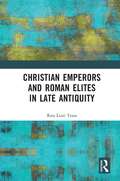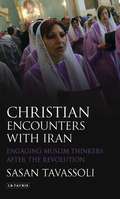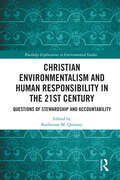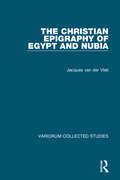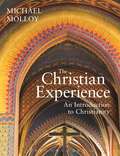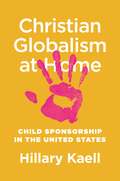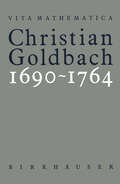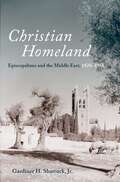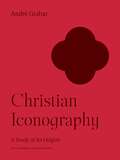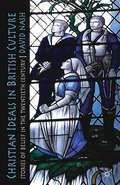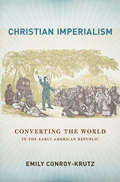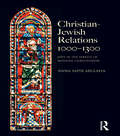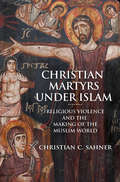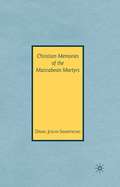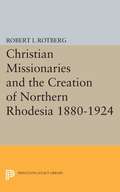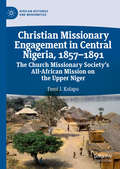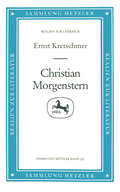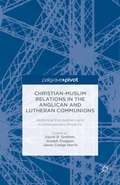- Table View
- List View
Christian Emperors and Roman Elites in Late Antiquity
by Rita Lizzi TestaThis book brings together a number of case studies to show some of the ways in which, as soon as the Roman Senate gained new political authority under Constantine and his successors, its members crowded the political scene in the West. In these chapters, Rita Lizzi Testa makes much of her work – the fruit of decades of research –available in English for the first time. The focus is on the aristocratics' passion for aruspical science, the political use of exphrastic poems, and even their control of the hagiographic genre in the late sixth century. She demonstrates how Roman senators were chosen as legates to establish proactive relations with Christian emperors, their ministers and military commanders, and Eastern and Western provincial elites. Senators wove a web of relations in the Eastern and Western empires, sewing and stitching the empire's fabric with their diplomatic skills, wealth, and influence, while lively and highly litigious assembly activity still required of them a cultured rhetoric. Through employing astute political strategies, they maintained their privileges, including their own beliefs in ancient cults. Christian Emperors and Roman Elites in Late Antiquity provides a crucial collection for students and scholars of Late Antique history and religion, and of politics in the Late Roman Empire.
Christian Encounters with Iran: Engaging Muslim Thinkers after the Revolution (International Library of Iranian Studies)
by Sasan TavassoliThe interface between the current Shi'ite landscape and Christian thinking is of the greatest significance for the shifting political and religious dynamics of the Middle East. Sasan Tavassoli here examines Iranian Shi'ite thinkers' encounters with Christian thought since the Islamic revolution of 1979, and argues that Iranian Shi'ite thinkers are increasingly engaged in multi-faceted theological engagements with Christian thought. Three recent developments provide insight into the cultural and intellectual climate surrounding Christian-Muslim dialogue in contemporary Iran. The literature on Christianity available in Iran reveals a wide range of approaches and attitudes, and Tavassoli demonstrates that traditional polemics are giving way to a more descriptive and subjective understanding of Christian thought. A significant part of Muslim-Christian dialogue in Iran is conducted through inter-faith dialogue and research conducted and supported by governmental as well as non-governmental organizations, and recent developments mark a departure from traditional debates in the history of Muslim-Christian interactions. Finally, Tavassoli offers a close study of three prominent liberal religious intellectuals - Abdol Karim Soroush, Mostafa Malekian and Mojtahed Shabestari - and their dynamic interaction with Christian thought, through a discussion of their writings as well as interviews. He explores their contribution to the ongoing understanding of Christianity in Shi'ite Iran. 'Christian Encounters with Iran' places contemporary Shi'ite thought in the broad historical context of pre- and post-revolution Iran, and relates the concrete religious, cultural and socio-political realities of Iran to the themes and orientations in the latest phase of the Shi'i Islam-Christianity encounter. It thus offers fresh insight into the dynamism of contemporary Islam and the religious complexities of the Muslim world.
Christian Environmentalism and Human Responsibility in the 21st Century: Questions of Stewardship and Accountability (Routledge Explorations in Environmental Studies)
by Katherine M. QuinseyChristian Environmentalism and Human Responsibility in the 21st Century comprises original scholarly essays and creative works exploring the implications of Christian environmentalism through literary and cultural criticism and creative reflection. The volume draws on a flourishing recent body of Christian ecocriticism and environmental activity, incorporating both practical ethics and environmental spirituality, but with particular emphasis on the notion of human responsibility. It discusses responsibility in its dual sense, as both the recognized cause of environmental destruction and the ethical imperative of accountability to the nonhuman environment. The book crosses boundaries between traditional scholarly and creative reflection through a global range of topics: African oral tradition, Ohio artists off the grid, immigrant self-metaphors of land and sea, iconic writers from Milton to O’Connor to Atwood, and Indigenous Canadian models for listening to the nonhuman Mother of us all. In its incorporation of academic and creative pieces from scholars and creative artists across North America, this volume shows how environmental work of its nature and necessity crosses traditional academic and community boundaries. In both form and orientation, this collection speaks to the most urgent intellectual, physical, social, and spiritual needs of the present day. This book will appeal to scholars, researchers, and upper-level students interested in the relationship between religion and environment, ethics, animal welfare, poetry, memoir, and post-secularism.
Christian Environmentalism and Human Responsibility in the 21st Century: Questions of Stewardship and Accountability (Routledge Explorations in Environmental Studies)
by Katherine M. QuinseyChristian Environmentalism and Human Responsibility in the 21st Century comprises original scholarly essays and creative works exploring the implications of Christian environmentalism through literary and cultural criticism and creative reflection. The volume draws on a flourishing recent body of Christian ecocriticism and environmental activity, incorporating both practical ethics and environmental spirituality, but with particular emphasis on the notion of human responsibility. It discusses responsibility in its dual sense, as both the recognized cause of environmental destruction and the ethical imperative of accountability to the nonhuman environment. The book crosses boundaries between traditional scholarly and creative reflection through a global range of topics: African oral tradition, Ohio artists off the grid, immigrant self-metaphors of land and sea, iconic writers from Milton to O’Connor to Atwood, and Indigenous Canadian models for listening to the nonhuman Mother of us all. In its incorporation of academic and creative pieces from scholars and creative artists across North America, this volume shows how environmental work of its nature and necessity crosses traditional academic and community boundaries. In both form and orientation, this collection speaks to the most urgent intellectual, physical, social, and spiritual needs of the present day. This book will appeal to scholars, researchers, and upper-level students interested in the relationship between religion and environment, ethics, animal welfare, poetry, memoir, and post-secularism.
The Christian Epigraphy of Egypt and Nubia (Variorum Collected Studies)
by Jacques van der VlietCollected Studies CS1070 The present book collects 31 articles that Jacques van der Vliet, a leading scholar in the field of Coptic Studies (Leiden University / Radboud University, Nijmegen), has published since 1999 on Christian inscriptions from Egypt and Nubia. These inscriptions are dated between the third/fourth and the fourteenth centuries, and are often written in Coptic and/or Greek, once in Latin, and sometimes (partly) in Arabic, Syriac or Old Nubian. They include inscriptions on tomb stones, walls of religious buildings, tools, vessels, furniture, amulets and even texts on luxury garments. Whereas earlier scholars in the field of Coptic Studies often focused on either Coptic or Greek, Van der Vliet argues that inscriptions in different languages that appear in the same space or on the same kind of objects should be examined together. In addition, he aims to combine the information from documentary texts, archaeological remains and inscriptions, in order to reconstruct the economic, social and religious life of monastic or civil communities. He practiced this methodology in his studies on the Fayum, Wadi al-Natrun, Sohag, Western Thebes and the region of Aswan and Northern Nubia, which are all included in this book.
The Christian Epigraphy of Egypt and Nubia (Variorum Collected Studies)
by Jacques van der VlietCollected Studies CS1070 The present book collects 31 articles that Jacques van der Vliet, a leading scholar in the field of Coptic Studies (Leiden University / Radboud University, Nijmegen), has published since 1999 on Christian inscriptions from Egypt and Nubia. These inscriptions are dated between the third/fourth and the fourteenth centuries, and are often written in Coptic and/or Greek, once in Latin, and sometimes (partly) in Arabic, Syriac or Old Nubian. They include inscriptions on tomb stones, walls of religious buildings, tools, vessels, furniture, amulets and even texts on luxury garments. Whereas earlier scholars in the field of Coptic Studies often focused on either Coptic or Greek, Van der Vliet argues that inscriptions in different languages that appear in the same space or on the same kind of objects should be examined together. In addition, he aims to combine the information from documentary texts, archaeological remains and inscriptions, in order to reconstruct the economic, social and religious life of monastic or civil communities. He practiced this methodology in his studies on the Fayum, Wadi al-Natrun, Sohag, Western Thebes and the region of Aswan and Northern Nubia, which are all included in this book.
The Christian Experience: An Introduction to Christianity
by Michael MolloyHow do we study Christian life and thought? How have political and cultural events influenced the experiences of Christians in different places, at different times? How has the world's largest religion been lived in varied parts of the world?The Christian Experience is the first textbook to unite traditional approaches to Christianity with special attention to art, music, architecture, and lived experiences. The material, individual, and personal sides of Christianity are brought to the fore throughout this chronological survey. Every chapter begins with a "first encounter" in order to bring the subject matter to life for students, mirroring the author's approach in his successful book Experiencing the World's Religions. This book on Christianity features over 100 color images, maps, and diagrams, and each chapter ends by pointing to additional print and electronic resources.Michael Molloy considers practices, insights, and artistic creations of Christians across the centuries. The book shows how Christian belief is being practiced in our own time, and it invites readers to imagine how Christianity might evolve in the future.
The Christian Experience: An Introduction to Christianity
by Michael MolloyHow do we study Christian life and thought? How have political and cultural events influenced the experiences of Christians in different places, at different times? How has the world's largest religion been lived in varied parts of the world?The Christian Experience is the first textbook to unite traditional approaches to Christianity with special attention to art, music, architecture, and lived experiences. The material, individual, and personal sides of Christianity are brought to the fore throughout this chronological survey. Every chapter begins with a "first encounter" in order to bring the subject matter to life for students, mirroring the author's approach in his successful book Experiencing the World's Religions. This book on Christianity features over 100 color images, maps, and diagrams, and each chapter ends by pointing to additional print and electronic resources.Michael Molloy considers practices, insights, and artistic creations of Christians across the centuries. The book shows how Christian belief is being practiced in our own time, and it invites readers to imagine how Christianity might evolve in the future.
Christian Globalism at Home: Child Sponsorship in the United States
by Christian Global Hillary KaellAn exploration of how ordinary U.S. Christians create global connections through the multibillion-dollar child sponsorship industryChild sponsorship emerged from nineteenth-century Protestant missions to become one of today’s most profitable private fund-raising tools in organizations including World Vision, Compassion International, and ChildFund. Investigating two centuries of sponsorship and its related practices in American living rooms, churches, and shopping malls, Christian Globalism at Home reveals the myriad ways that Christians who don’t travel outside of the United States cultivate global sensibilities.Kaell traces the movement of money, letters, and images, along with a wide array of sponsorship’s lesser-known embodied and aesthetic techniques, such as playacting, hymn singing, eating, and fasting. She shows how, through this process, U.S. Christians attempt to hone globalism of a particular sort by oscillating between the sensory experiences of a God’s eye view and the intimacy of human relatedness. These global aspirations are buoyed by grand hopes and subject to intractable limitations, since they so often rely on the inequities they claim to redress.Based on extensive interviews, archival research, and fieldwork, Christian Globalism at Home explores how U.S. Christians imagine and experience the world without ever leaving home.
Christian Globalism at Home: Child Sponsorship in the United States
by Christian Global Hillary KaellAn exploration of how ordinary U.S. Christians create global connections through the multibillion-dollar child sponsorship industryChild sponsorship emerged from nineteenth-century Protestant missions to become one of today’s most profitable private fund-raising tools in organizations including World Vision, Compassion International, and ChildFund. Investigating two centuries of sponsorship and its related practices in American living rooms, churches, and shopping malls, Christian Globalism at Home reveals the myriad ways that Christians who don’t travel outside of the United States cultivate global sensibilities.Kaell traces the movement of money, letters, and images, along with a wide array of sponsorship’s lesser-known embodied and aesthetic techniques, such as playacting, hymn singing, eating, and fasting. She shows how, through this process, U.S. Christians attempt to hone globalism of a particular sort by oscillating between the sensory experiences of a God’s eye view and the intimacy of human relatedness. These global aspirations are buoyed by grand hopes and subject to intractable limitations, since they so often rely on the inequities they claim to redress.Based on extensive interviews, archival research, and fieldwork, Christian Globalism at Home explores how U.S. Christians imagine and experience the world without ever leaving home.
Christian Goldbach 1690–1764 (Vita Mathematica #8)
by Adolf A. Jushkevic Judith K. Kopelevic FellmannChristian Homeland: Episcopalians and the Middle East, 1820-1958
by Gardiner H. Shattuck, Jr.Christian Homeland focuses on the involvement of clergy and prominent laity of the Episcopal Church in Middle Eastern affairs, both religious and political, between the Greek War of Independence (1821-1829) and the Second Arab-Israeli War (1956-1957), with a brief epilogue covering additional events up to the present day. As the birthplace of the Christian faith, the Middle East had always been an area of fascination to church people in the West, and with the expansion of American diplomatic and commercial interests into the Mediterranean in the early nineteenth century, Episcopalians and other American Protestants felt called to similarly export their religious values into the region. Beginning in the 1830s, Episcopalians established mission posts in Athens and Constantinople (Istanbul), from which they sought to convert Muslims and Jews to Christianity. Having failed to achieve any appreciable evangelistic success with non-Christians, they soon turned their attention to reforming the ancient churches of the East instead. Later assisted by the Church of England's missionary bishopric in Jerusalem, a small, but influential corps of Episcopalians dedicated themselves to keeping church members informed about the Middle East, particularly the status of the region's Christian population, well into the twentieth century. This book analyses how the theological ideas held by Episcopal church leaders not only guided missionary and religious activities, but also influenced their denomination's response to major social and political questions of the late nineteenth and early twentieth centuries issues such as immigration into the United States, genocide, wartime refugee relief, anti-Semitism, Zionism, and the Palestinian Nakba.
Christian Homeland: Episcopalians and the Middle East, 1820-1958
by Gardiner H. Shattuck, Jr.Christian Homeland focuses on the involvement of clergy and prominent laity of the Episcopal Church in Middle Eastern affairs, both religious and political, between the Greek War of Independence (1821-1829) and the Second Arab-Israeli War (1956-1957), with a brief epilogue covering additional events up to the present day. As the birthplace of the Christian faith, the Middle East had always been an area of fascination to church people in the West, and with the expansion of American diplomatic and commercial interests into the Mediterranean in the early nineteenth century, Episcopalians and other American Protestants felt called to similarly export their religious values into the region. Beginning in the 1830s, Episcopalians established mission posts in Athens and Constantinople (Istanbul), from which they sought to convert Muslims and Jews to Christianity. Having failed to achieve any appreciable evangelistic success with non-Christians, they soon turned their attention to reforming the ancient churches of the East instead. Later assisted by the Church of England's missionary bishopric in Jerusalem, a small, but influential corps of Episcopalians dedicated themselves to keeping church members informed about the Middle East, particularly the status of the region's Christian population, well into the twentieth century. This book analyses how the theological ideas held by Episcopal church leaders not only guided missionary and religious activities, but also influenced their denomination's response to major social and political questions of the late nineteenth and early twentieth centuries issues such as immigration into the United States, genocide, wartime refugee relief, anti-Semitism, Zionism, and the Palestinian Nakba.
Christian Iconography: A Study of Its Origins (The A. W. Mellon Lectures in the Fine Arts #10)
by André GrabarAn illuminating look at the iconography of the early church and its important place in the history of Christian artIn this book, historian André Grabar demonstrates how early Christian iconography assimilated contemporary imagery of the time. Grabar looks at the most characteristic examples of paleo-Christian iconography, dwelling on their nature, form, and content. He explores the limits of originality in such art, its debt to figurative art, and the broader cultural climate in the Roman Empire, drawing a distinction between expressive images—that is, genuine works of art—and informative ones. Throughout, Grabar establishes the importance of imperial iconography in the development of Christian portraits and sheds light on the role they played alongside other forms of Christian piety in their day.
Christian Ideals in British Culture: Stories of Belief in the Twentieth Century
by D. NashThis book offers a challenge to conventional histories of secularisation by focusing upon the importance of central religious narratives. These narratives are changed significantly over time, but also to have been invested with importance and meaning by religious individuals and organisations as well as by secular ones.
Christian Imperialism: Converting the World in the Early American Republic (The United States in the World)
by Emily Conroy-KrutzIn 1812, eight American missionaries, under the direction of the recently formed American Board of Commissioners for Foreign Missions, sailed from the United States to South Asia. The plans that motivated their voyage were ano less grand than taking part in the Protestant conversion of the entire world. Over the next several decades, these men and women were joined by hundreds more American missionaries at stations all over the globe. Emily Conroy-Krutz shows the surprising extent of the early missionary impulse and demonstrates that American evangelical Protestants of the early nineteenth century were motivated by Christian imperialism—an understanding of international relations that asserted the duty of supposedly Christian nations, such as the United States and Britain, to use their colonial and commercial power to spread Christianity. In describing how American missionaries interacted with a range of foreign locations (including India, Liberia, the Middle East, the Pacific Islands, North America, and Singapore) and imperial contexts, Christian Imperialism provides a new perspective on how Americans thought of their country’s role in the world. While in the early republican period many were engaged in territorial expansion in the west, missionary supporters looked east and across the seas toward Africa, Asia, and the Pacific. Conroy-Krutz’s history of the mission movement reveals that strong Anglo-American and global connections persisted through the early republic. Considering Britain and its empire to be models for their work, the missionaries of the American Board attempted to convert the globe into the image of Anglo-American civilization.
Christian Jewish Relations 1000-1300: Jews in the Service of Medieval Christendom (The Medieval World)
by Anna Sapir AbulafiaThe history of relations between Jews and Christians has been a long, complex and often unsettled one; yet histories of medieval Christendom have traditionally paid only passing attention to the role played by Jews in a predominantly Christian society. This book provides an original survey of medieval Christian-Jewish relations encompassing England, Spain, France and Germany, and sheds light in the process on the major developments in medieval history between 1000 and 1300. Anna Sapir Abulafia's balanced yet humane account offers a new perspective on Christian-Jewish relations by analysing the theological, socio-economic and political services Jews were required to render to medieval Christendom. The nature of Jewish service varied greatly as Christian rulers struggled to reconcile the desire to profit from the presence of Jewish men and women in their lands with conflicting theological notions about Judaism. Jews meanwhile had to deal with the many competing authorities and interests in the localities in which they lived; their continued presence hinged on a fine balance between theology and pragmatism. The book examines the impact of the Crusades on Christian-Jewish relations and analyses how anti-Jewish libels were used to define relations. Making adept use of both Latin and Hebrew sources, Abulafia draws on liturgical and exegetical material, and narrative, polemical and legal sources, to give a vivid and accurate sense of how Christians interacted with Jews and Jews with Christians.
Christian Jewish Relations 1000-1300: Jews in the Service of Medieval Christendom (The Medieval World)
by Anna Sapir AbulafiaThe history of relations between Jews and Christians has been a long, complex and often unsettled one; yet histories of medieval Christendom have traditionally paid only passing attention to the role played by Jews in a predominantly Christian society. This book provides an original survey of medieval Christian-Jewish relations encompassing England, Spain, France and Germany, and sheds light in the process on the major developments in medieval history between 1000 and 1300. Anna Sapir Abulafia's balanced yet humane account offers a new perspective on Christian-Jewish relations by analysing the theological, socio-economic and political services Jews were required to render to medieval Christendom. The nature of Jewish service varied greatly as Christian rulers struggled to reconcile the desire to profit from the presence of Jewish men and women in their lands with conflicting theological notions about Judaism. Jews meanwhile had to deal with the many competing authorities and interests in the localities in which they lived; their continued presence hinged on a fine balance between theology and pragmatism. The book examines the impact of the Crusades on Christian-Jewish relations and analyses how anti-Jewish libels were used to define relations. Making adept use of both Latin and Hebrew sources, Abulafia draws on liturgical and exegetical material, and narrative, polemical and legal sources, to give a vivid and accurate sense of how Christians interacted with Jews and Jews with Christians.
Christian Martyrs under Islam: Religious Violence and the Making of the Muslim World
by Christian C. SahnerHow did the medieval Middle East transform from a majority-Christian world to a majority-Muslim world, and what role did violence play in this process? Christian Martyrs under Islam explains how Christians across the early Islamic caliphate slowly converted to the faith of the Arab conquerors and how small groups of individuals rejected this faith through dramatic acts of resistance, including apostasy and blasphemy.Using previously untapped sources in a range of Middle Eastern languages, Christian Sahner introduces an unknown group of martyrs who were executed at the hands of Muslim officials between the seventh and ninth centuries CE. Found in places as diverse as Syria, Spain, Egypt, and Armenia, they include an alleged descendant of Muhammad who converted to Christianity, high-ranking Christian secretaries of the Muslim state who viciously insulted the Prophet, and the children of mixed marriages between Muslims and Christians. Sahner argues that Christians never experienced systematic persecution under the early caliphs, and indeed, they remained the largest portion of the population in the greater Middle East for centuries after the Arab conquest. Still, episodes of ferocious violence contributed to the spread of Islam within Christian societies, and memories of this bloodshed played a key role in shaping Christian identity in the new Islamic empire. Christian Martyrs under Islam examines how violence against Christians ended the age of porous religious boundaries and laid the foundations for more antagonistic Muslim-Christian relations in the centuries to come.
Christian Martyrs under Islam: Religious Violence and the Making of the Muslim World
by Christian C. SahnerHow did the medieval Middle East transform from a majority-Christian world to a majority-Muslim world, and what role did violence play in this process? Christian Martyrs under Islam explains how Christians across the early Islamic caliphate slowly converted to the faith of the Arab conquerors and how small groups of individuals rejected this faith through dramatic acts of resistance, including apostasy and blasphemy.Using previously untapped sources in a range of Middle Eastern languages, Christian Sahner introduces an unknown group of martyrs who were executed at the hands of Muslim officials between the seventh and ninth centuries CE. Found in places as diverse as Syria, Spain, Egypt, and Armenia, they include an alleged descendant of Muhammad who converted to Christianity, high-ranking Christian secretaries of the Muslim state who viciously insulted the Prophet, and the children of mixed marriages between Muslims and Christians. Sahner argues that Christians never experienced systematic persecution under the early caliphs, and indeed, they remained the largest portion of the population in the greater Middle East for centuries after the Arab conquest. Still, episodes of ferocious violence contributed to the spread of Islam within Christian societies, and memories of this bloodshed played a key role in shaping Christian identity in the new Islamic empire. Christian Martyrs under Islam examines how violence against Christians ended the age of porous religious boundaries and laid the foundations for more antagonistic Muslim-Christian relations in the centuries to come.
Christian Memories of the Maccabean Martyrs
by D. Joslyn-SiemiatkoskiThis book examines texts and materials, ranging from the eastern Mediterranean to northwestern Europe, related to the Maccabean martyrs. Joslyn-Siemiatkoski demonstrates that Christian thinkers constructed memories of the Maccabean martyrs that simultaneously appropriated Jewish traditions and obscured the Jewish origins of Christianity.
Christian Missionaries and the Creation of Northern Rhodesia 1880-1924 (PDF)
by Robert I. RotbergA study of the contribution made by Christian missionaries to the formation of Northern Rhodesia based on firsthand information and study by the author, who has visited nearly every mission station in Northern Rhodesia, consulted missionary diaries, journals, and records.Originally published in 1965.The Princeton Legacy Library uses the latest print-on-demand technology to again make available previously out-of-print books from the distinguished backlist of Princeton University Press. These editions preserve the original texts of these important books while presenting them in durable paperback and hardcover editions. The goal of the Princeton Legacy Library is to vastly increase access to the rich scholarly heritage found in the thousands of books published by Princeton University Press since its founding in 1905.
Christian Missionary Engagement in Central Nigeria, 1857–1891: The Church Missionary Society's All-African Mission on the Upper Niger (African Histories and Modernities)
by Femi J. KolapoIn the decades before colonial partition in Africa, the Church Missionary Society embarked on the first serious effort to evangelize in an independent Muslim state. Bishop Samuel Ajayi Crowther led an all-African field staff to convert the people of the Upper Niger and Confluence area, whose communities were threatened or already conquered by an expanding jihadist Nupe state. In this book, Femi J. Kolapo examines the significance of the mission as an African—rather than European—undertaking, assessing its impact on missionary practice, local engagement, and Christian conversion prospects. By offering a fuller history of this overlooked mission in the history of Christianity in Nigeria, this book reaffirms indigenous agency and rethinks the mission as an experiment ahead of its time.
Christian-Muslim Relations in the Anglican and Lutheran Communions: Historical Encounters And Contemporary Projects
by David D. Grafton Joseph F. Duggan Jason Craige HarrisUsing vignettes of Muslim-Christian engagement within the Anglican and Lutheran communities from around the world, this book provides thoughtful Anglican and Lutheran responses to Muslim-Christian relationships from a variety of perspectives and contexts, lays the groundwork for ongoing faithful, sensitive, and sincere engagement.
